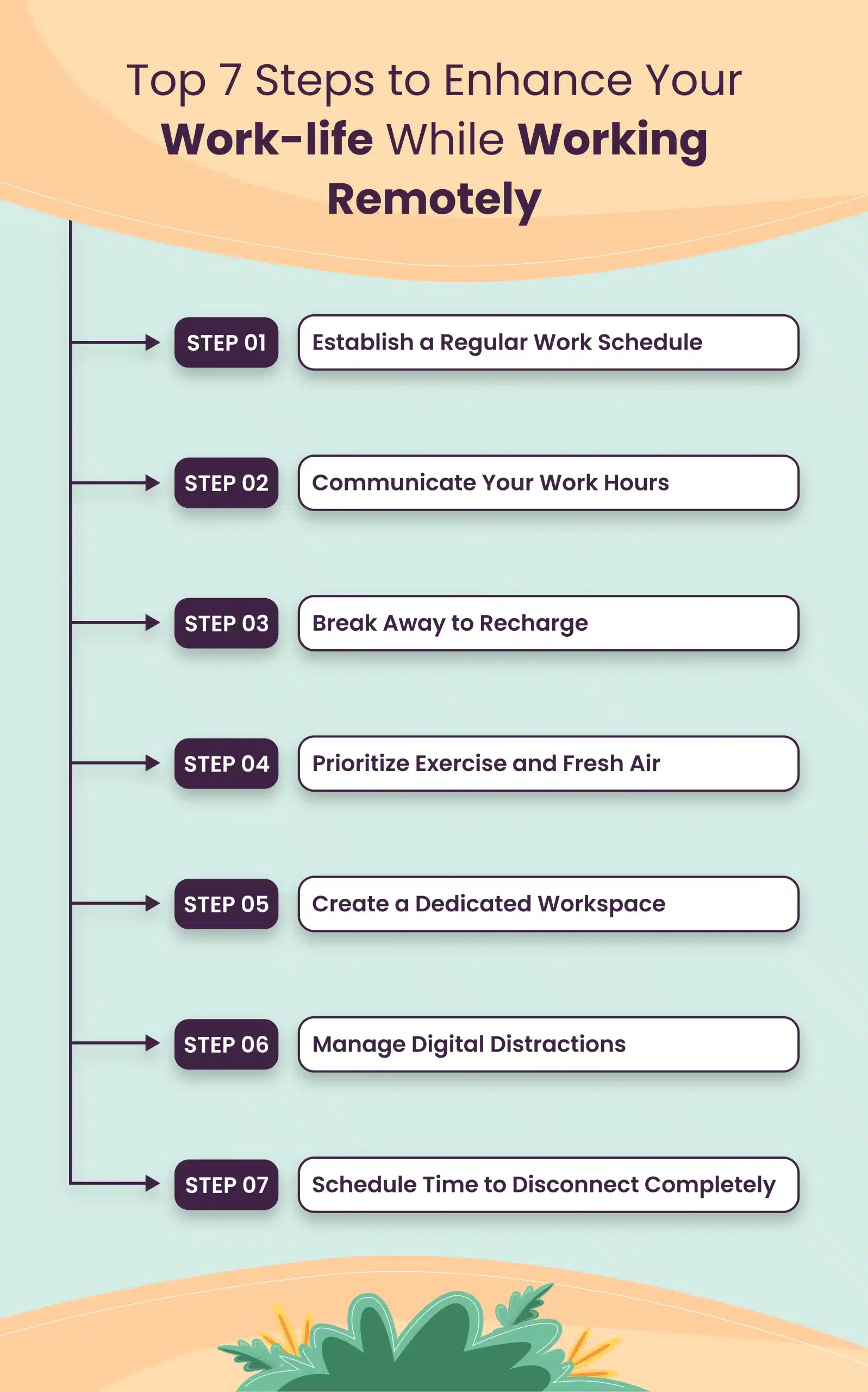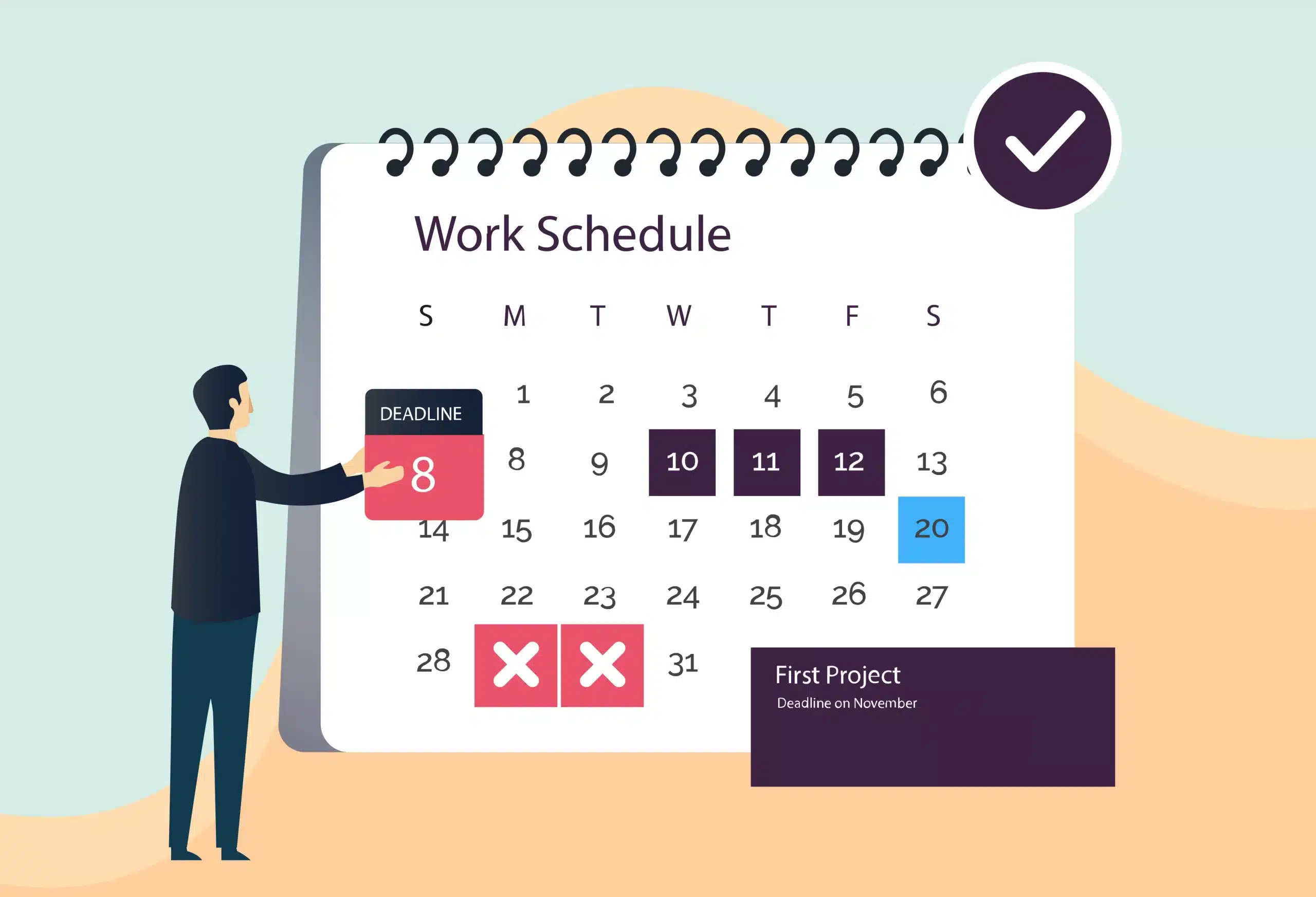Table of content
How As more companies adopt remote work policies, it’s essential to maintain a healthy work-life balance. Working from home or a remote location definitely has its advantages, but it can also blur the lines between work and personal life.
According to a Gallup study, 45% of employees in the United States work remotely at least some of the time. Remote work has many benefits, including reducing stress and improving work-life balance. However, it can be difficult to maintain a healthy balance between work and personal life when working remotely.
In this blog post, we will look at some practical tips for keeping a healthy balance between work and personal life when working remotely.
Top 7 Steps to Enhance Your Work-life While Working Remotely
The line between work and personal life can easily blur when your office is also your home. This can lead to feelings of isolation, stress, and, ultimately, burnout. The good news is there are steps you can take to create a healthy work-life balance while working remotely. Here are our top 7 tips to help you thrive in this new work environment:
Establish a Regular Work Schedule
Just because your boss isn’t physically looking over your shoulder doesn’t mean you should ditch a schedule altogether. Creating a daily routine that separates your work hours from your time is crucial for establishing healthy boundaries and maintaining a sense of normalcy. This routine helps your brain switch gears and prevents work from creeping into your evenings and weekends.
If you traditionally worked 9 to 5 in an office setting, there was a clear separation between work and home life. Remote work can disrupt that separation, making it easy to feel like you’re always “on.” By establishing a set work schedule, you signal to your brain (and those around you) when it’s time to focus and when it’s time to relax and recharge.
Communicate Your Work Hours
Treat your home office with the same respect you would a traditional office. Setting clear boundaries is important to maintain a healthy work-life balance. Communicate your work hours to colleagues and family members. This can involve simple steps like letting your housemates know when you’re in a meeting or setting specific times for checking emails.
Clear communication helps avoid disruptions during work time. Let’s say you’re in the middle of a complex coding task, and your roommate decides to crank up the music for a cleaning session. Establishing boundaries can prevent these interruptions and enhance your focus on your tasks without distractions.
Break Away to Recharge
Don’t underestimate the power of a short break! Schedule regular mini-vacations throughout your day to stretch, grab a coffee, step outside for fresh air, or do a few jumping jacks. These breaks may seem insignificant, but they’re essential for refreshing your mind and boosting your focus.
Think of your brain like a muscle. Like any muscle, it needs rest periods to function at its best. Taking short breaks or sleep naps throughout the day helps prevent mental fatigue and allows you to refresh your focus and creativity to help maintain work-life balance.
Here’s a tip: Set a timer for 25 minutes and focus intently on your work during that period. Once the timer goes off, take a five-minute break to stretch, grab a drink, or do something else that helps you relax. Repeating these focused work intervals with short breaks can significantly improve productivity.
Prioritize Exercise and Fresh Air
Remote work can make you feel cooped up, especially when the weather isn’t ideal. Make a conscious effort to get outside for some sunshine and exercise.
Physical activity is a well-known stress reliever and mood booster. Exercise releases endorphins, which have mood-lifting and pain-relieving properties. Furthermore, outdoor time can improve your focus, creativity, and well-being.
Create a Dedicated Workspace
Despite the flexibility of a strong remote work culture, allowing you to work from anywhere, establishing a dedicated workspace in your home can significantly improve your focus and productivity.
Ideally, this workspace should be free from distractions and clutter and equipped with the tools you need to perform your job effectively. This could be a spare bedroom converted into a home office, a quiet corner of your living room, or even a designated spot at your kitchen table.
Manage Digital Distractions
The constant barrage of work emails, notifications, and social media updates can be a major productivity killer. While staying connected is essential, managing these digital distractions effectively is crucial.
To combat digital distractions, you can put your devices and communication platforms’ on “Do Not Disturb” modes. Schedule these quiet periods strategically to minimize interruptions during focused work times.
Additionally, audit your inbox and unsubscribe from unnecessary emails or mailing lists that clutter your workspace and steal your attention. Consider turning off push notifications for non-essential applications as well.
Instead of constantly refreshing your inbox, try batching your email checking. Designate specific times throughout the day to address your emails. This lets you focus on other tasks without constantly getting sidetracked by incoming messages.
Schedule Time to Disconnect Completely
While staying connected is often a requirement of remote work, scheduling time to disconnect completely is equally essential. Think about it this way: if you constantly have your phone glued to your hand, checking emails and responding to messages even during your time, you’re never truly giving your mind a break.
This constant connection can lead to stress, burnout, and difficulty focusing when you need to work. To counteract this, build disconnection into your routine. Dedicate specific evenings or weekends as “tech-free” zones. During this time, power down your devices and resist the urge to check emails. Focus on relaxing activities that don’t involve screens, like spending more time with family pursuing hobbies, or simply unwinding with a good book.
Note: – If you’re an employer looking to hire top tech talents, then we will recommend reading our best tools to evaluate remote hiring tips. It will help you in hiring remote employees efficiently.
Wrapping Up!
When you’re working remotely, maintaining a healthy work-life balance is crucial for overall well-being and productivity. Remote workers can effectively separate work from personal life by establishing a regular work schedule, communicating boundaries, taking regular breaks, prioritizing exercise and fresh air, creating a dedicated workspace, and managing digital distractions.
Additionally, scheduling time to disconnect completely is essential for recharging and preventing burnout. By implementing these practical tips, remote workers can enjoy the benefits of remote work while ensuring a healthy balance between work and personal life.










